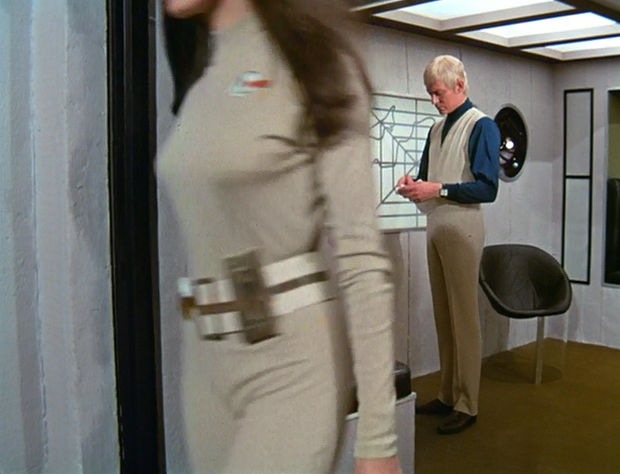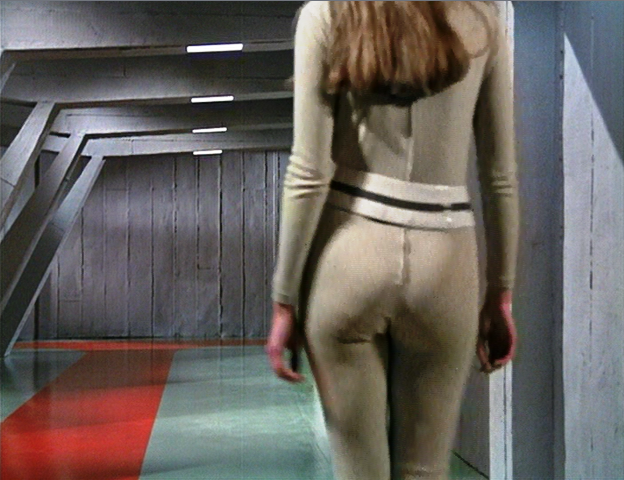I delayed featuring Gerry Anderson's UFO here on my "Outre Intro" series for some time. I absolutely love the unforgettable introduction for this program, but I also knew that it would take forever to get all the screen-grabs that I would need to conduct the critical breakdown and analysis.
Why? This brilliant introductory montage features more than double the amount of imagery of a typical TV show intro, and many of the images are near-subliminal flash-cuts. And yet the vast majority of these images are vital, and help to cogently convey the nature of the series.
I admire UFO's introductory montage so much because I feel it accomplishes two crucial artistic tasks.
First, the intro -- through the auspices of a recurring computer teletype print-out -- familiarizes the viewer with every aspect of SHADO's (Supreme Headquarters Alien Defense Organisation) organization.
We see each location or installation on the series in turn, and then the vessels, vehicles and personnel operating at them.
Secondly, the intro explores the vibe or atmosphere of this unique, futuristic series.
Set in the future year of 1980, UFO imagines that the swinging sixties never ended, and that there was a two-decade planetary renaissance in both sex and technology leading up to 1980.
I dub this unique conceit or aesthetic "T and A." It's not what you think. The "T" there stands for "technology" not something else.
The "A" as before, involves the beauty of the human form. The images mix futuristic technology with highly sexual images of the human form.
The intro for UFO very much focuses on the "T and A" of it future world, thus providing readers a texture of its futuristic world. Also important, and crucial to UFO's tapestry, the introduction focuses on the multi-racial, or international face of Earth's defenses. Racism in the freewheeling, high-tech world of UFO, is a thing of the past.
The imagery of the introduction starts with the very reason for the war. We meet an alien invader. The image below features not just an invader, but the nature of the secret invasion.
We see a fake eyeball being removed, and thus glean the idea that there is a surface and an underneath to the future world depicted in the series. This aesthetic applies not just to the aliens (who often operate in secret), but to our stalwart, human defenders.
Next up, we begin the recurring teletype motif, which familiarizes us with every aspect of SHADO's operation. Interestingly, a kind of space teletype print-out, spelling out the nature of the atomic disaster, was also deployed for Year Two of another Anderson production: Space: 1999.
The first of our jump or flash cuts comes next. After learning the nature of SHADO's headquarters from the vibrating teletype, we get a title screen reminding us of the organization's title. Why use jump-cuts in this fashion?
These jump cuts not only convey information, they add to the jaunty, fast-paced atmosphere of the proceedings. The future is a place of technology, sex, equality, and hyper-realized information. The bullet points convey a no-nonsense attitude, but also the speed at which "the future" moves and acts.
Next, we actually see the film studio mentioned by the print-out, the "surface image" that clouds or disguises the underneath image. This is literal, not figurative. Above we have Harlington-Straker Film Studios. Beneath, we have SHADO's command HQ.
Next, another jump-cut, this one defining the year in which the action is set. Importantly, this is a year -- 1980 -- that most viewers in 1970 knew they would live to see.
Part of UFO's mystique and appeal is simply that it occurs in a high-tech, equality-based, sexual near future. Of course, today we are well past the year 1980, and know that this imaginative future did not come to be. So the same quality that made UFO so appealing -- it's near-future world -- also makes it, today, seem, perhaps, dated.
Now, we begin to meet the people who populate the HQ.
Our first view is of a very attractive woman, perhaps of Middle Eastern or Indian descent. She appears beautiful, friendly, and competent. She wears the uniform of SHADO. The message here is that the future will be a place of equality.
It is not only the world of white European or American men. People from all nations of the world are working together to meet and vanquish the secret threat.
In the next shot, we meet our hero, Ed Straker (Ed Bishop), the man in charge of this installation, and the officer in charge of SHADO.
His punk styled haircut -- on a figure of establishment, no less -- reveals that fashion has changed a great deal by 1980. What was once considered fringe or counter-culture has now been assimilated into the mainstream.
Below is another T and A-styled shot.While Straker works intently in his high-tech office, a beautiful and fit SHADOW female operative exits from the same room.
If the shot above features the "A" or "flesh" part of the "T and A" equation, the shots below go back to the tech aspect. We see Straker examining a model of some type, and then approaching a computer console.
Another shot reveals other operatives hunched over another computer. In the future, technology will serve our planet, and we will interface with it for positive reasons, these images suggest.
Now, we alternate back to the "A" in the T and A equation.
And back again to the "T" for technology.
The next grouping of images focus on several UFO cast members in quick succession. You will notice that all wear absolutely grave expressions.
These grim countenances are important, because they also convey the nature and importance of this location.
The control or HQ portion of SHADO calls the shots. And those shots, as we know once we meet Straker, are often heart-breaking and difficult.
The following images reveal the gravity of this decision-making.
The first portion of the introduction is now done, and so we return to the teletype print-out, to learn about the second aspect of the SHADO operation.
Specifically, we meet SID, a satellite in Earth orbit that warns of nearing UFOs. After the teletype introduces us to SID, we get a series of images which portray its nature and purpose.
Specifically, we meet SID, a satellite in Earth orbit that warns of nearing UFOs. After the teletype introduces us to SID, we get a series of images which portray its nature and purpose.
Again, we get a reminder of the year.
By 1980, we will have unmanned ships in space, operated by computers. And they will help us defend the Earth from invasion.
By 1980, we will have unmanned ships in space, operated by computers. And they will help us defend the Earth from invasion.
Just as we saw details of the HQ beneath the film studio, we now drill-down to become better acquainted with SID. First, an exterior view of the satellite.
Next, a jump cut explaining the reason for SID's existence.
Finally, below, we get a series of shots revealing the "T" (for technology) that keeps SID in orbit, as it were.
Once more, we get the notion of a future of amazing technology. In that amazing future, technology is our friend, and our last line of defense.
Below, we return again to the teletype, and it reveals another element of Earth's defense: Skydiver.
Skydiver is a submarine/plane combo that can shoot UFOs out of the sky.
The detailed shots of Skydiver's crew reveal, once more, that fashion has become highly sexualized.
The "A" in T and A here involves not just beautiful women, but also very fit men who wear see-through mesh suits!
The "A" in T and A here involves not just beautiful women, but also very fit men who wear see-through mesh suits!
Next, the teletype returns for a fourth report about SHADO's resources.
Now, we see the Mobiles moving on land.
Just as we met an Indian woman above, in the SHADO HQ segment of the introduction, here we see a black man operating key aspects of SHADO technology.
This visual reminds us that in the future imagined by the Andersons, racism has burned itself out, and is no longer a consideration in terms of service, competence, or achievement.
This visual reminds us that in the future imagined by the Andersons, racism has burned itself out, and is no longer a consideration in terms of service, competence, or achievement.
Our first visual of the alien craft comes next.
As Mobiles approach, a landed vehicle opens fire on it, and the fireworks are spectacular.
This too is a key appeal of UFO: the intricate, still-impressive miniature and visual effects.
Finally, we get to the last teletype message or info dump, showing us a further line of defense: Moonbase.
Below we meet Nina Barry, a black woman, and again, her nature is important. She is the commander of Moonbase in 1980.
Racism has not prevented her brilliance, skill and talent from being recognized and honored.
Once more, we see re-asserted the "T and A" (Technology and Ass, essentially) dynamic. Below, moonbase is visualized as high-tech and futuristic, and the personnel are seen as gorgeous and fit.
The last sections of the introduction feature Interceptors launched, firing missiles at a UFO approaching Earth.
The UFO is destroyed, and it is mission accomplished forSHADO, an operation we now thoroughly understand.
More than that, we understand the high-tech, sexualized, racially equal nature of the society on Earth it represents.
The UFO is destroyed, and it is mission accomplished forSHADO, an operation we now thoroughly understand.
More than that, we understand the high-tech, sexualized, racially equal nature of the society on Earth it represents.
You can see the stunning UFO introduction in all its live-action glory, below. Barry Gray's jazzy, up-tempo theme renders the whole thing pacey, sexy, "mod" (in a swinging sixties kind of way) and unforgettable.
























































































I loved this opening ever since I was a very young boy in the fall of 1972 and saw the U.S. television debut of UFO.
ReplyDeleteSGB
I also love the brief piece of music that accompanies the Century 21 Production graphic in that first screen grab. There is a prog rock group called Rocket Scientists who have done versions of this theme and Space:1999 that can be found on YouTube.
ReplyDelete